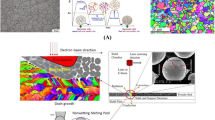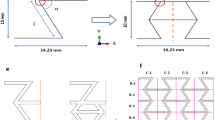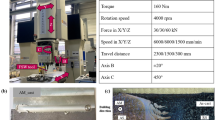Abstract
The amount of damage induced during hot forming depends not only on the stress state but also on material softening due to dynamic recrystallization (DRX), which can be used to delay or reduce damage initiation. An extension to the Gurson–Tvergaard–Needleman (GTN) model has been proposed recently that includes a new coupled DRX-damage nucleation criterion taking DRX and the stress state into account. In the present paper, a 4-pass caliber rolling process is considered where the bar stock is rotated by 90° after each rolling pass. The extended GTN model is applied to the caliber rolling process to predict the internal damage induced during the rolling process. The simulation results show that the highest void volume fraction (VVF) occurs during the first rolling pass. However, the variations of stress state during each pass assist in reducing the damage in the subsequent passes. The material softening due to increasing DRX in subsequent passes also helps to reduce the void nucleation. The microscopic analysis of the rolled bar confirms the damage distribution predicted by the simulations.

















Similar content being viewed by others
References
Ervasti E, Ståhlberg U (2005) Void initiation close to a macro-inclusion during single pass reductions in the hot rolling of steel slabs: a numerical study. J Mater Process Technol 170(1–2):142–150
Børvik T, Hopperstad O, Berstad T et al (2001) A computational model of viscoplasticity and ductile damage for impact and penetration. Eur J Mech A Solids 20(5):685–712
Johnson GR, Cook WH (1985) Fracture characteristics of three metals subjected to various strains, strain rates, temperatures and pressures. Eng Fract Mech 21(1):31–48
Buchely M, Aken D, O’Malley R et al (2017) Hot rolling effect upon the high temperature Johnson–Cook strength and failure models for a 15V38 grade steel. In: MS&T17, pp 1045–1053
Oyane M, Sato T, Okimoto K et al (1980) Criteria for ductile fracture and their applications. J Mech Work Technol 4(1):65–81
Wang C, Geijselaers H, Omerspahic E et al (2016) Influence of ring growth rate on damage development in hot ring rolling. J Mater Process Technol 227:268–280
Novella MF, Ghiotti A, Bruschi S et al (2015) Ductile damage modeling at elevated temperature applied to the cross wedge rolling of AA6082-T6 bars. J Mater Process Technol 222:259–267
Wang X, Chandrashekhara K, Rummel SA et al (2017) Modeling of mass flow behavior of hot rolled low alloy steel based on combined Johnson–Cook and Zerilli–Armstrong model. J Mater Sci 52(5):2800–2815
Kwon HC, Lee HW, Kim HY et al (2009) Surface wrinkle defect of carbon steel in the hot bar rolling process. J Mater Process Technol 209(9):4476–4483
Sakai T, Satio Y, Hirano K et al (1988) Deformation and recrystallization behavior of low carbon steel in high speed hot rolling. Trans Iron Steel Inst Jpn 28(12):1028–1035
Tekkaya AE, Ben Khalifa N, Hering O et al (2017) Forming-induced damage and its effects on product properties. CIRP Ann 66(1):281–284
Tvergaard V, Needleman A (1984) Analysis of the cup-cone fracture in a round tensile bar. Acta Metall 32(1):157–169
Farrugia DCJ (2006) Prediction and avoidance of high temperature damage in long product hot rolling. J Mater Process Technol 177(1–3):486–492
Ying L, Liu W, Wang D et al (2016) Ductile failure analysis of high strength steel in hot forming based on micromechanical damage model. MATEC Web Conf 80(15):3002
Imran M, Bambach M (2018) Towards the damage evaluation using Gurson–Tvergaard–Needleman (GTN) model for hot forming processes. In: Proceedings of the 21st international ESAFORM conference on material forming: ESAFORM 2018, p 170006
Imran M, Szyndler J, Afzal MJ et al (2019) Dynamic recrystallization-dependent damage modeling during hot forming. Int J Damage Mech 55:105678951984847
Bambach M, Imran M (2019) Extended Gurson–Tvergaard–Needleman model for damage modeling and control in hot forming. CIRP Ann 68(1):249–252
Acknowledgements
The authors thank the financial support of the Deutsche Forschungsgemeinschaft (DFG, German Research Foundation) through project A01 (Institute of Metal Forming, RWTH Aachen), B04 (Central Facility for Electron Microscopy, RWTH Aachen) and C03 (Chair of Mechanical Design and Manufacturing, BTU Cottbus-Senftenberg) of the Transregional Collaborative Research (Projektnummer 278868966-TRR 188) on “Damage Controlled Forming Processes”. We also thank the project partners in project S01 (Institute of Forming Technology and Lightweight Construction, TU Dortmund) for providing the original GTN model.
Author information
Authors and Affiliations
Corresponding author
Additional information
Publisher's Note
Springer Nature remains neutral with regard to jurisdictional claims in published maps and institutional affiliations.
Rights and permissions
About this article
Cite this article
Imran, M., Afzal, M.J., Buhl, J. et al. Evaluation of process-induced damage based on dynamic recrystallization during hot caliber rolling. Prod. Eng. Res. Devel. 14, 5–16 (2020). https://doi.org/10.1007/s11740-019-00932-0
Received:
Accepted:
Published:
Issue Date:
DOI: https://doi.org/10.1007/s11740-019-00932-0




